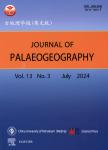Sedimentary and environmental history of the Late Permian Bonikowo Reef(Zechstein Limestone, Wuchiapingian), western Poland
Sedimentary and environmental history of the Late Permian Bonikowo Reef(Zechstein Limestone, Wuchiapingian), western Poland作者机构:Institute of Geological Sciences University of Wroc?aw Polish Geological Instituted-National Research Institute Institute of Agrophysics Polish Academy of Sciences
出 版 物:《Journal of Palaeogeography》 (古地理学报(英文版))
年 卷 期:2017年第6卷第3期
页 面:183-205页
核心收录:
学科分类:0303[法学-社会学] 0710[理学-生物学] 070903[理学-古生物学与地层学(含:古人类学)] 0709[理学-地质学] 07[理学] 0708[理学-地球物理学] 0705[理学-地理学] 0815[工学-水利工程] 0813[工学-建筑学] 0833[工学-城乡规划学]
基 金:financed by the National Science Centre (No. DEC-2013/11/B/ST10/04949)
主 题:Bonikowo Reef Zechstein Limestone Wuchiapingian Biofacies Carbon and oxygen isotopes
摘 要:The Bonikowo Reef occurs in the central part of the Zechstein Limestone Basin in western Poland and was growing on the topmost edges of tilted blocks and/or on the top of uplifted horsts of the BrandenburgeWolsztynePogorzela High. Its size is ca. 1.6 km^2. The Bonikowo Reef shows the thickest reef section(90.5 m) recorded in the High. The Zechstein Limestone unit is represented mostly by limestones, often thoroughly recrystallized, although the macrotextures and biota of the boundstone are identifiable in most cases. The drillcore section is a mixture of boundstones(microbial and bryozoan), wackestones, packstones and grainstones, which often co-occur. The δ^13 C and δ^18 O values for both calcite(avg. 3.8 ± 0.8‰ and-3.4 ± 1.7‰, respectively) and dolomite(avg. 3.5 ± 0.7‰ and-5.2 ± 1.3‰, respectively) are transitional between the values previously reported for condensed sequences of the basinal facies and larger reef complexes. The biofacies of the Bonikowo Reef are very similar to those recognized in other reefs of the BrandenburgeWolsztynePogorzela High, which owe their origin to the destruction of bryozoan boundstones. The biota composition is typical and characteristic of other Zechstein Limestone reefs. However, the Bonikowo Reef demonstrates the importance of microbialites, laminar and nodose encrustations, in the growth and cohesion of the Zechstein Limestone reefs. Such encrustations abound within the Zechstein Limestone although, in many cases, the real nature of the encrustations is difficult to ascertain. These laminated encrustations show great similarity to Archaeolithoporella that is one of the most important Permian reefbuilding organisms. The encrustations considered to represent Archaeolithoporella were also previously recorded in the Zechstein Limestone of western Poland and in its stratigraphic equivalent, the Middle Magnesian Limestone of Northeast England. The lower part of the sequence shows great biofacies variability that reflects common envir



